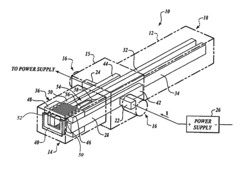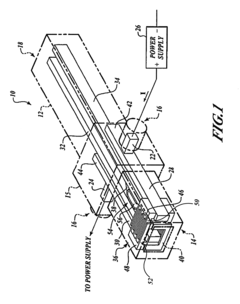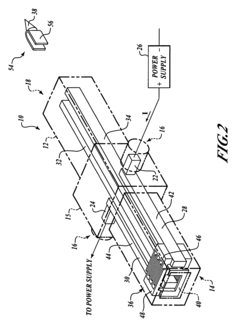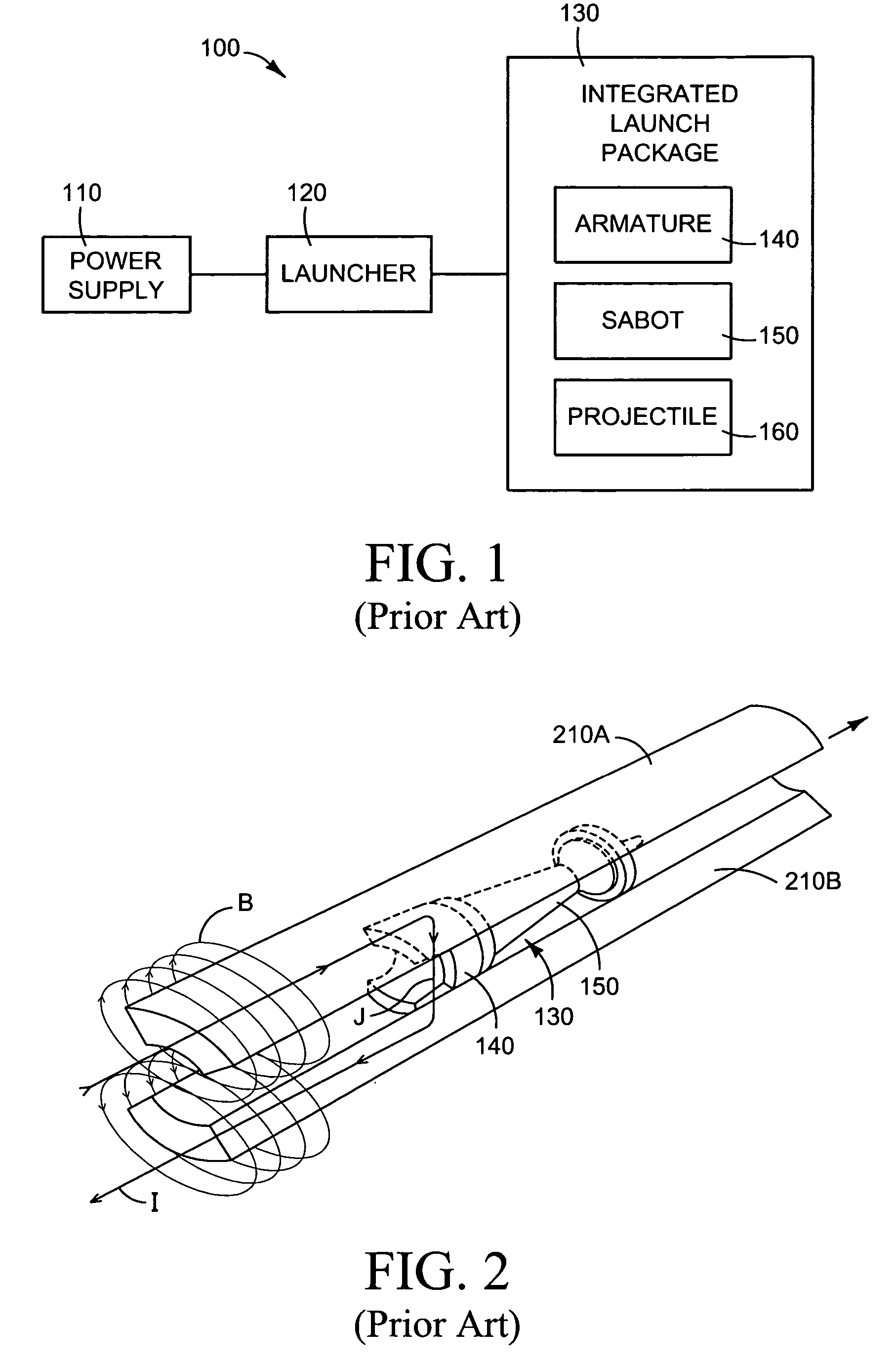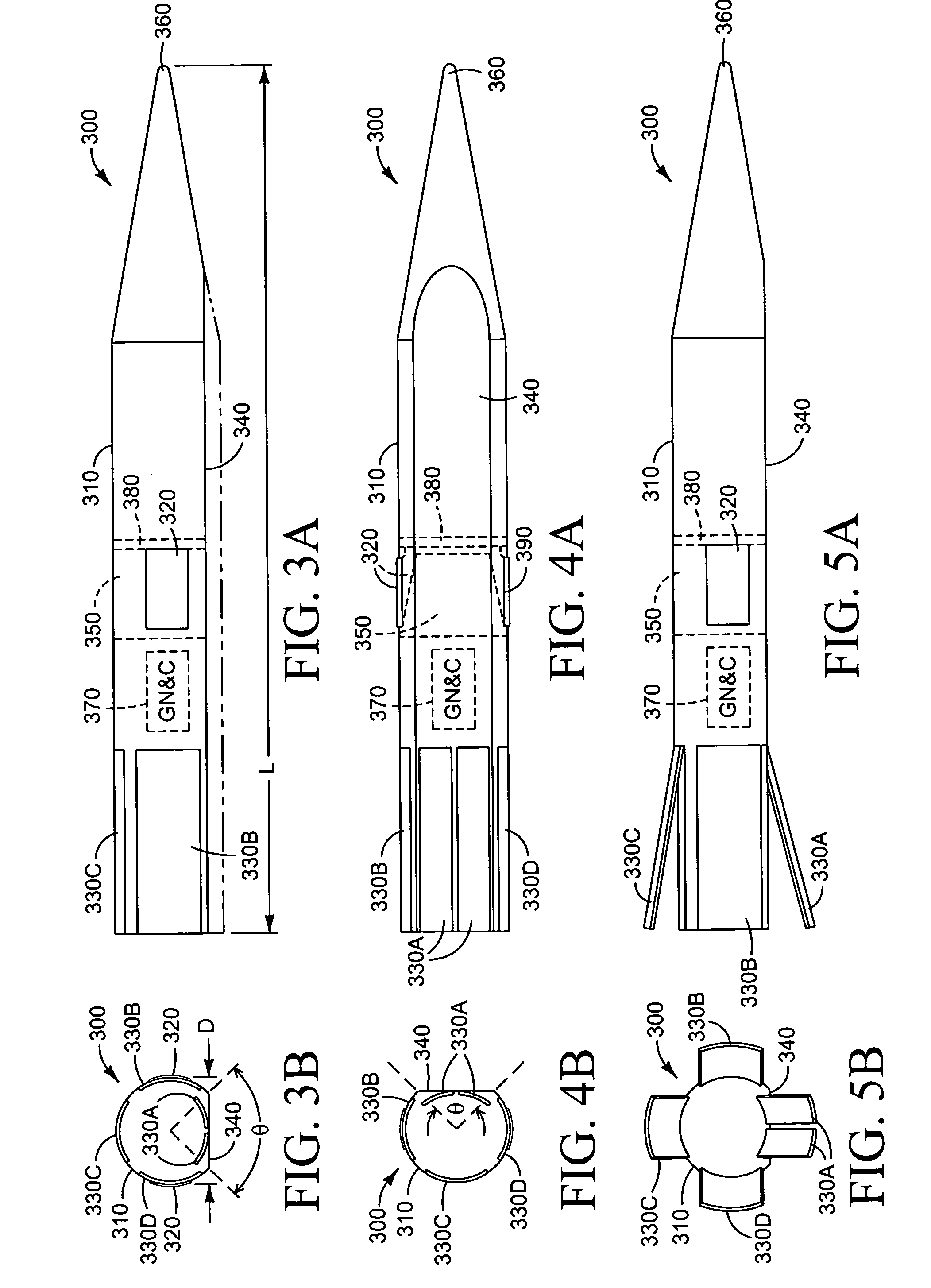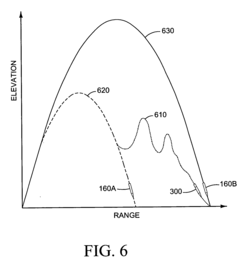Rail Gun Usage in Anti-Submarine Warfare Tactics
AUG 6, 20258 MIN READ
Generate Your Research Report Instantly with AI Agent
Patsnap Eureka helps you evaluate technical feasibility & market potential.
Rail Gun ASW Evolution
The evolution of rail gun technology for anti-submarine warfare (ASW) represents a significant shift in naval combat capabilities. Initially developed for surface warfare, rail guns have recently been adapted for underwater applications, marking a new era in ASW tactics.
In the early stages, rail gun technology focused primarily on land-based and ship-to-ship engagements. The concept of using electromagnetic force to launch projectiles at hypersonic speeds was first explored in the mid-20th century. However, it wasn't until the late 1990s and early 2000s that serious research and development began for naval applications.
The adaptation of rail guns for ASW purposes began in the 2010s, as navies sought more effective ways to counter increasingly sophisticated submarine threats. This shift was driven by the limitations of traditional ASW weapons, such as depth charges and torpedoes, which were becoming less effective against modern, quieter submarines.
The first phase of rail gun ASW evolution involved modifying existing rail gun designs to create projectiles capable of penetrating water effectively. This required overcoming significant challenges, including maintaining projectile stability upon water entry and minimizing energy loss underwater.
By the mid-2020s, prototype rail gun systems specifically designed for ASW began emerging. These systems utilized specialized projectiles with hydrodynamic profiles and advanced guidance systems, capable of tracking and engaging submerged targets at extended ranges.
A key milestone in rail gun ASW evolution was the development of multi-mode projectiles. These innovative munitions could transition from air to water, maintaining high velocities and accuracy throughout their trajectory. This breakthrough significantly expanded the engagement envelope for ASW operations.
Recent advancements have focused on integrating rail gun ASW systems with advanced sensor networks and artificial intelligence. This integration allows for real-time target acquisition, tracking, and engagement, greatly enhancing the effectiveness of ASW operations.
The latest phase of rail gun ASW evolution involves the development of autonomous underwater vehicles (AUVs) equipped with miniaturized rail gun technology. These AUVs can operate in swarms, providing a distributed and highly mobile ASW capability that can penetrate denied areas and engage submarines at close range.
As rail gun technology continues to mature, its role in ASW is expected to grow significantly. Future developments may include the integration of rail guns with directed energy weapons, creating hybrid systems capable of engaging multiple types of threats across various domains.
In the early stages, rail gun technology focused primarily on land-based and ship-to-ship engagements. The concept of using electromagnetic force to launch projectiles at hypersonic speeds was first explored in the mid-20th century. However, it wasn't until the late 1990s and early 2000s that serious research and development began for naval applications.
The adaptation of rail guns for ASW purposes began in the 2010s, as navies sought more effective ways to counter increasingly sophisticated submarine threats. This shift was driven by the limitations of traditional ASW weapons, such as depth charges and torpedoes, which were becoming less effective against modern, quieter submarines.
The first phase of rail gun ASW evolution involved modifying existing rail gun designs to create projectiles capable of penetrating water effectively. This required overcoming significant challenges, including maintaining projectile stability upon water entry and minimizing energy loss underwater.
By the mid-2020s, prototype rail gun systems specifically designed for ASW began emerging. These systems utilized specialized projectiles with hydrodynamic profiles and advanced guidance systems, capable of tracking and engaging submerged targets at extended ranges.
A key milestone in rail gun ASW evolution was the development of multi-mode projectiles. These innovative munitions could transition from air to water, maintaining high velocities and accuracy throughout their trajectory. This breakthrough significantly expanded the engagement envelope for ASW operations.
Recent advancements have focused on integrating rail gun ASW systems with advanced sensor networks and artificial intelligence. This integration allows for real-time target acquisition, tracking, and engagement, greatly enhancing the effectiveness of ASW operations.
The latest phase of rail gun ASW evolution involves the development of autonomous underwater vehicles (AUVs) equipped with miniaturized rail gun technology. These AUVs can operate in swarms, providing a distributed and highly mobile ASW capability that can penetrate denied areas and engage submarines at close range.
As rail gun technology continues to mature, its role in ASW is expected to grow significantly. Future developments may include the integration of rail guns with directed energy weapons, creating hybrid systems capable of engaging multiple types of threats across various domains.
Naval Warfare Demands
The evolving landscape of naval warfare has placed increasing demands on anti-submarine warfare (ASW) capabilities. Traditional ASW tactics have relied heavily on sonar systems, depth charges, and torpedoes. However, the advent of more sophisticated submarine technologies, including quieter propulsion systems and advanced stealth features, has necessitated the exploration of innovative solutions to maintain strategic advantage in underwater combat scenarios.
Rail gun technology, traditionally associated with surface warfare, has emerged as a potential game-changer in ASW tactics. The high-velocity projectiles fired by rail guns offer several advantages that align with the current needs of naval forces engaged in submarine detection and neutralization. These advantages include extended range, increased penetration capabilities, and reduced reaction times compared to conventional ASW weapons.
The integration of rail guns into ASW tactics addresses several key demands of modern naval warfare. Firstly, it provides a means to engage submarines at greater distances, potentially beyond the effective range of submarine-launched weapons. This extended reach enhances the survivability of surface vessels and expands the operational envelope of ASW missions.
Secondly, the hypervelocity nature of rail gun projectiles offers the potential to overcome the challenges posed by hardened submarine hulls and advanced defensive systems. The kinetic energy imparted by these projectiles may prove effective in disabling or destroying submerged targets, even without the use of explosive warheads.
Furthermore, the rapid-fire capability of rail guns aligns with the need for quick response times in ASW scenarios. The ability to launch multiple projectiles in rapid succession increases the probability of a successful engagement, particularly against highly maneuverable targets.
The demand for more cost-effective ASW solutions is also addressed by rail gun technology. While the initial investment in rail gun systems may be substantial, the per-shot cost of inert projectiles is significantly lower than that of conventional guided munitions. This cost efficiency becomes particularly relevant in protracted ASW operations or when dealing with multiple submarine threats.
Lastly, the versatility of rail gun systems offers naval forces the flexibility to engage both surface and subsurface targets with a single weapons platform. This multi-role capability is increasingly valued in modern naval operations, where ships must be prepared to respond to diverse threats in rapidly changing combat environments.
As naval warfare continues to evolve, the integration of rail gun technology into ASW tactics represents a response to the growing sophistication of submarine threats and the need for more effective countermeasures. The potential of this technology to reshape underwater combat strategies underscores its significance in meeting the demands of contemporary naval warfare.
Rail gun technology, traditionally associated with surface warfare, has emerged as a potential game-changer in ASW tactics. The high-velocity projectiles fired by rail guns offer several advantages that align with the current needs of naval forces engaged in submarine detection and neutralization. These advantages include extended range, increased penetration capabilities, and reduced reaction times compared to conventional ASW weapons.
The integration of rail guns into ASW tactics addresses several key demands of modern naval warfare. Firstly, it provides a means to engage submarines at greater distances, potentially beyond the effective range of submarine-launched weapons. This extended reach enhances the survivability of surface vessels and expands the operational envelope of ASW missions.
Secondly, the hypervelocity nature of rail gun projectiles offers the potential to overcome the challenges posed by hardened submarine hulls and advanced defensive systems. The kinetic energy imparted by these projectiles may prove effective in disabling or destroying submerged targets, even without the use of explosive warheads.
Furthermore, the rapid-fire capability of rail guns aligns with the need for quick response times in ASW scenarios. The ability to launch multiple projectiles in rapid succession increases the probability of a successful engagement, particularly against highly maneuverable targets.
The demand for more cost-effective ASW solutions is also addressed by rail gun technology. While the initial investment in rail gun systems may be substantial, the per-shot cost of inert projectiles is significantly lower than that of conventional guided munitions. This cost efficiency becomes particularly relevant in protracted ASW operations or when dealing with multiple submarine threats.
Lastly, the versatility of rail gun systems offers naval forces the flexibility to engage both surface and subsurface targets with a single weapons platform. This multi-role capability is increasingly valued in modern naval operations, where ships must be prepared to respond to diverse threats in rapidly changing combat environments.
As naval warfare continues to evolve, the integration of rail gun technology into ASW tactics represents a response to the growing sophistication of submarine threats and the need for more effective countermeasures. The potential of this technology to reshape underwater combat strategies underscores its significance in meeting the demands of contemporary naval warfare.
Rail Gun ASW Challenges
The integration of rail gun technology into anti-submarine warfare (ASW) tactics presents several significant challenges that must be addressed for effective implementation. One of the primary obstacles is the adaptation of rail gun systems, traditionally designed for surface and land-based targets, to the unique requirements of underwater warfare.
The first major challenge lies in the projectile design. Conventional rail gun projectiles are optimized for atmospheric flight, but for ASW applications, they must be capable of penetrating water efficiently while maintaining accuracy and lethality. This necessitates the development of specialized projectiles that can withstand the extreme forces of rail gun launch and still perform effectively in an aqueous environment.
Another critical issue is the detection and tracking of submarines at rail gun-compatible ranges. While rail guns offer extended range compared to traditional naval guns, they still require precise target data to be effective. Integrating rail gun systems with advanced sonar and other submarine detection technologies is crucial but presents significant technical hurdles in terms of data processing and real-time targeting.
The power requirements for rail gun systems pose another substantial challenge. Naval vessels must be capable of generating and storing enormous amounts of electrical energy to power these weapons effectively. This may require redesigning ship power systems and potentially limit the use of rail guns to larger vessels, impacting tactical flexibility in ASW operations.
Environmental factors also present significant challenges. The effects of electromagnetic pulses generated by rail guns on sensitive ASW equipment, such as sonar systems, must be carefully managed. Additionally, the acoustic signature of rail gun firing could potentially compromise the firing vessel's position, a critical concern in ASW scenarios.
Durability and maintenance of rail gun systems in marine environments is another area of concern. The corrosive nature of seawater and the high-stress operating conditions of naval vessels require robust engineering solutions to ensure reliability and longevity of these advanced weapon systems.
Lastly, the integration of rail gun ASW capabilities into existing naval doctrine and tactics presents operational challenges. Naval forces must develop new strategies and procedures to effectively utilize the unique characteristics of rail guns in ASW, including their extended range, high velocity, and potential for rapid engagement of multiple targets.
The first major challenge lies in the projectile design. Conventional rail gun projectiles are optimized for atmospheric flight, but for ASW applications, they must be capable of penetrating water efficiently while maintaining accuracy and lethality. This necessitates the development of specialized projectiles that can withstand the extreme forces of rail gun launch and still perform effectively in an aqueous environment.
Another critical issue is the detection and tracking of submarines at rail gun-compatible ranges. While rail guns offer extended range compared to traditional naval guns, they still require precise target data to be effective. Integrating rail gun systems with advanced sonar and other submarine detection technologies is crucial but presents significant technical hurdles in terms of data processing and real-time targeting.
The power requirements for rail gun systems pose another substantial challenge. Naval vessels must be capable of generating and storing enormous amounts of electrical energy to power these weapons effectively. This may require redesigning ship power systems and potentially limit the use of rail guns to larger vessels, impacting tactical flexibility in ASW operations.
Environmental factors also present significant challenges. The effects of electromagnetic pulses generated by rail guns on sensitive ASW equipment, such as sonar systems, must be carefully managed. Additionally, the acoustic signature of rail gun firing could potentially compromise the firing vessel's position, a critical concern in ASW scenarios.
Durability and maintenance of rail gun systems in marine environments is another area of concern. The corrosive nature of seawater and the high-stress operating conditions of naval vessels require robust engineering solutions to ensure reliability and longevity of these advanced weapon systems.
Lastly, the integration of rail gun ASW capabilities into existing naval doctrine and tactics presents operational challenges. Naval forces must develop new strategies and procedures to effectively utilize the unique characteristics of rail guns in ASW, including their extended range, high velocity, and potential for rapid engagement of multiple targets.
Current Rail Gun ASW
01 Electromagnetic rail gun design
Rail guns use electromagnetic forces to accelerate projectiles to high velocities. The design typically involves parallel conducting rails and a sliding armature. When current flows through the system, it creates a powerful magnetic field that propels the projectile forward. This technology offers advantages in terms of projectile speed and range compared to traditional firearms.- Electromagnetic rail gun design: Rail guns use electromagnetic forces to accelerate projectiles to high velocities. The design typically involves parallel conducting rails and a sliding armature. When a large electric current is passed through the rails and armature, it creates a powerful magnetic field that propels the projectile forward at extremely high speeds.
- Power supply and energy storage systems: Efficient power supply and energy storage systems are crucial for rail gun operation. These systems often involve high-capacity capacitors or pulse-forming networks to deliver the intense bursts of electrical energy required to launch projectiles. Advanced power management techniques are employed to optimize energy delivery and improve overall system performance.
- Projectile design and materials: Specialized projectiles are developed for rail guns to withstand the extreme forces and temperatures experienced during launch. These projectiles often incorporate advanced materials and aerodynamic designs to maximize range, accuracy, and impact energy. Considerations include heat resistance, structural integrity, and electromagnetic properties.
- Rail and armature materials: The choice of materials for rails and armatures is critical in rail gun design. Materials must possess high electrical conductivity, mechanical strength, and wear resistance to withstand the extreme conditions during firing. Research focuses on developing novel alloys and composite materials to improve performance and durability of these components.
- Control systems and fire control: Advanced control systems are essential for precise operation of rail guns. These systems manage power delivery, timing, and projectile release. Fire control systems integrate sensors, targeting algorithms, and environmental data to improve accuracy and effectiveness. Automation and intelligent control mechanisms are being developed to enhance overall system performance.
02 Power supply and energy storage systems
Efficient power supply and energy storage are crucial for rail gun operation. This includes high-capacity capacitors, pulse-forming networks, and advanced battery technologies. These systems must be capable of delivering extremely high currents in short bursts to generate the electromagnetic forces required for projectile acceleration.Expand Specific Solutions03 Projectile design and materials
Specialized projectiles are developed for rail guns to withstand the extreme forces and temperatures involved in electromagnetic acceleration. These projectiles often incorporate advanced materials and aerodynamic designs to maximize range, accuracy, and impact energy. Considerations include conductivity, structural integrity, and heat resistance.Expand Specific Solutions04 Rail and armature materials
The choice of materials for rails and armatures is critical in rail gun design. These components must withstand extreme electrical currents, mechanical stress, and thermal loads. Research focuses on developing materials with high conductivity, strength, and wear resistance to improve rail gun performance and longevity.Expand Specific Solutions05 Control systems and fire control
Advanced control systems are essential for accurate and reliable rail gun operation. This includes precise timing of current delivery, projectile loading mechanisms, and targeting systems. Fire control systems integrate sensors, computational models, and user interfaces to optimize rail gun performance in various operational scenarios.Expand Specific Solutions
Rail Gun ASW Patents
Electromagnetic launcher with augmenting breech
PatentActiveUS7730821B2
Innovation
- The design includes a slidable electromagnetic launcher housing with augmentation conductors and main conductors connected via a current cross-over connection, allowing for recoil accommodation while maintaining electrical contact, and reducing overall inductance by limiting augmentation to early stages of the launch cycle, facilitating faster current rise and balanced weight distribution.
Electromagnetic railgun projectile
PatentInactiveUS20070261543A1
Innovation
- The design includes an aeroshell with an integrated armature near the center-of-gravity and extendable flaps, allowing for increased lethality mass delivery and reduced armature transition by optimizing the aerodynamic lifting surface and flap control during flight.
Maritime Law Impact
The use of rail guns in anti-submarine warfare (ASW) tactics raises significant maritime law considerations. The deployment of such advanced weaponry in international waters must comply with established legal frameworks, including the United Nations Convention on the Law of the Sea (UNCLOS) and customary international law. These legal instruments govern the conduct of naval operations and the use of force at sea.
One key legal aspect is the principle of freedom of navigation, which allows warships to operate in international waters. However, the use of rail guns for ASW purposes must be balanced against the obligation to respect the rights and freedoms of other states. This includes the duty to exercise due regard for the safety of navigation and to refrain from any threat or use of force against the territorial integrity or political independence of any state.
The law of armed conflict also plays a crucial role in regulating the use of rail guns in ASW. The principles of distinction, proportionality, and military necessity must be adhered to when employing these weapons. Commanders must ensure that rail gun attacks are directed only at legitimate military targets and that the expected collateral damage is not excessive in relation to the anticipated military advantage.
Furthermore, the use of rail guns in ASW may have implications for environmental protection under maritime law. The potential impact on marine ecosystems and biodiversity must be considered, as states have an obligation to protect and preserve the marine environment. This includes taking measures to prevent, reduce, and control pollution from vessels, including warships engaged in ASW operations.
The legal status of rail guns under arms control agreements is another important consideration. While no specific treaty explicitly prohibits their use, the development and deployment of rail guns may be subject to interpretation under existing arms limitation agreements. States must carefully assess whether the use of rail guns in ASW tactics complies with their international obligations and commitments.
Lastly, the use of rail guns in ASW may raise questions of state responsibility and liability under international law. If the employment of these weapons results in damage to neutral vessels or coastal states' property, the operating state may be held accountable. This underscores the importance of developing clear rules of engagement and operational guidelines that align with maritime legal principles.
In conclusion, the integration of rail guns into ASW tactics necessitates a thorough examination of maritime law implications. Naval forces must navigate a complex legal landscape to ensure that the use of these advanced weapons remains within the bounds of international law while effectively addressing submarine threats.
One key legal aspect is the principle of freedom of navigation, which allows warships to operate in international waters. However, the use of rail guns for ASW purposes must be balanced against the obligation to respect the rights and freedoms of other states. This includes the duty to exercise due regard for the safety of navigation and to refrain from any threat or use of force against the territorial integrity or political independence of any state.
The law of armed conflict also plays a crucial role in regulating the use of rail guns in ASW. The principles of distinction, proportionality, and military necessity must be adhered to when employing these weapons. Commanders must ensure that rail gun attacks are directed only at legitimate military targets and that the expected collateral damage is not excessive in relation to the anticipated military advantage.
Furthermore, the use of rail guns in ASW may have implications for environmental protection under maritime law. The potential impact on marine ecosystems and biodiversity must be considered, as states have an obligation to protect and preserve the marine environment. This includes taking measures to prevent, reduce, and control pollution from vessels, including warships engaged in ASW operations.
The legal status of rail guns under arms control agreements is another important consideration. While no specific treaty explicitly prohibits their use, the development and deployment of rail guns may be subject to interpretation under existing arms limitation agreements. States must carefully assess whether the use of rail guns in ASW tactics complies with their international obligations and commitments.
Lastly, the use of rail guns in ASW may raise questions of state responsibility and liability under international law. If the employment of these weapons results in damage to neutral vessels or coastal states' property, the operating state may be held accountable. This underscores the importance of developing clear rules of engagement and operational guidelines that align with maritime legal principles.
In conclusion, the integration of rail guns into ASW tactics necessitates a thorough examination of maritime law implications. Naval forces must navigate a complex legal landscape to ensure that the use of these advanced weapons remains within the bounds of international law while effectively addressing submarine threats.
Environmental Effects
The environmental effects of rail gun usage in anti-submarine warfare (ASW) tactics are multifaceted and require careful consideration. The underwater environment presents unique challenges and opportunities for this advanced weapon system.
Firstly, the electromagnetic pulse generated by rail guns can significantly impact marine ecosystems. The high-energy discharge may disrupt the navigation and communication systems of various marine species, particularly those that rely on electromagnetic fields for orientation. This could lead to behavioral changes in marine life, potentially affecting migration patterns and feeding habits.
Water conductivity plays a crucial role in the effectiveness of rail guns in ASW. Saltwater, being an excellent conductor of electricity, can enhance the propagation of electromagnetic waves generated by the rail gun. This characteristic can potentially increase the detection range and accuracy of submarine targeting. However, it also means that the electromagnetic signature of the rail gun itself may be more easily detectable by enemy submarines, potentially compromising the element of surprise in ASW operations.
The acoustic impact of rail guns in underwater environments is another critical factor. The supersonic projectiles fired by rail guns create powerful shock waves upon entering the water. These shock waves can travel long distances underwater, potentially revealing the location of the firing platform to enemy submarines. Conversely, this acoustic signature could be leveraged as a deterrent, creating a psychological impact on submarine crews and influencing their tactical decisions.
Temperature and pressure variations in the ocean can affect the performance and accuracy of rail gun projectiles. As the projectile travels through different water layers with varying densities, its trajectory may be altered, requiring sophisticated guidance systems to maintain accuracy. Additionally, the extreme pressures at greater depths may impact the structural integrity of the projectiles, necessitating specialized designs for deep-water ASW operations.
The use of rail guns in ASW may also have implications for marine pollution. While rail guns do not use traditional explosive propellants, the high-velocity impact of projectiles can potentially release harmful materials into the marine environment. This could include metal fragments and other debris, which may have long-term effects on marine ecosystems and food chains.
Lastly, the electromagnetic interference generated by rail guns could potentially affect underwater communication systems and sonar equipment used in ASW operations. This may require the development of new, shielded technologies to ensure effective coordination and data exchange between ASW assets in the presence of rail gun operations.
Firstly, the electromagnetic pulse generated by rail guns can significantly impact marine ecosystems. The high-energy discharge may disrupt the navigation and communication systems of various marine species, particularly those that rely on electromagnetic fields for orientation. This could lead to behavioral changes in marine life, potentially affecting migration patterns and feeding habits.
Water conductivity plays a crucial role in the effectiveness of rail guns in ASW. Saltwater, being an excellent conductor of electricity, can enhance the propagation of electromagnetic waves generated by the rail gun. This characteristic can potentially increase the detection range and accuracy of submarine targeting. However, it also means that the electromagnetic signature of the rail gun itself may be more easily detectable by enemy submarines, potentially compromising the element of surprise in ASW operations.
The acoustic impact of rail guns in underwater environments is another critical factor. The supersonic projectiles fired by rail guns create powerful shock waves upon entering the water. These shock waves can travel long distances underwater, potentially revealing the location of the firing platform to enemy submarines. Conversely, this acoustic signature could be leveraged as a deterrent, creating a psychological impact on submarine crews and influencing their tactical decisions.
Temperature and pressure variations in the ocean can affect the performance and accuracy of rail gun projectiles. As the projectile travels through different water layers with varying densities, its trajectory may be altered, requiring sophisticated guidance systems to maintain accuracy. Additionally, the extreme pressures at greater depths may impact the structural integrity of the projectiles, necessitating specialized designs for deep-water ASW operations.
The use of rail guns in ASW may also have implications for marine pollution. While rail guns do not use traditional explosive propellants, the high-velocity impact of projectiles can potentially release harmful materials into the marine environment. This could include metal fragments and other debris, which may have long-term effects on marine ecosystems and food chains.
Lastly, the electromagnetic interference generated by rail guns could potentially affect underwater communication systems and sonar equipment used in ASW operations. This may require the development of new, shielded technologies to ensure effective coordination and data exchange between ASW assets in the presence of rail gun operations.
Unlock deeper insights with Patsnap Eureka Quick Research — get a full tech report to explore trends and direct your research. Try now!
Generate Your Research Report Instantly with AI Agent
Supercharge your innovation with Patsnap Eureka AI Agent Platform!
